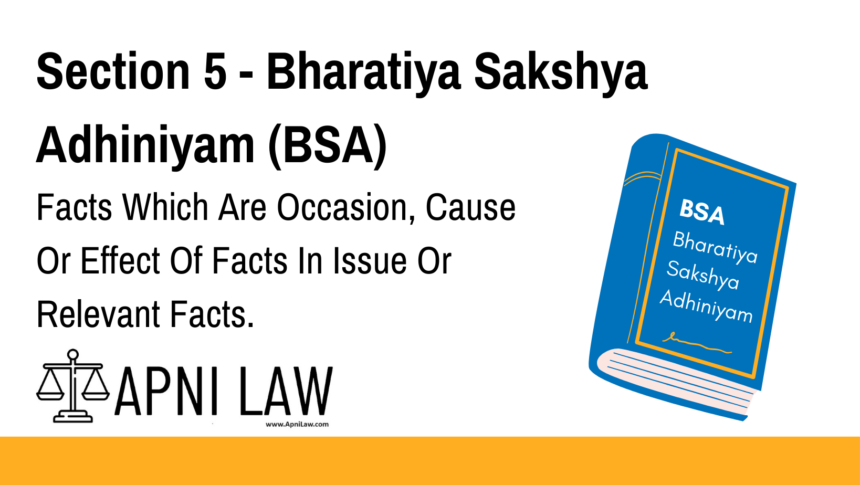Code
Facts which are the occasion, cause or effect, immediate or otherwise, of relevant
facts, or facts in issue, or which constitute the state of things under which they happened,
or which afforded an opportunity for their occurrence or transaction, are relevant.
Illustrations.
(a) The question is, whether A robbed B. The facts that, shortly before the robbery,
B went to a fair with money in his possession, and that he showed it, or mentioned the fact
that he had it, to third persons, are relevant.
(b) The question is, whether A murdered B. Marks on the ground, produced by a
struggle at or near the place where the murder was committed, are relevant facts.
(c) The question is, whether A poisoned B. The state of B’s health before the symptoms
ascribed to poison, and habits of B, known to A, which afforded an opportunity for the
administration of poison, are relevant facts.
Explanation
Section 5 of the BSA deals with facts that are indirectly linked to a fact in issue. If a fact either led to, resulted from, or set the stage for a fact in issue or relevant fact — then it becomes admissible.
This section essentially widens the evidentiary net. If the surroundings or circumstances help the court better understand how, why, or when something happened — they can be taken into account.
These include:
- Circumstantial causes leading to the event
- Effects that followed the event
- State of things under which the event took place
- Opportunities or enabling conditions for the act
Illustrations
- (a) The question is, whether A robbed B.
➤ The facts that, shortly before the robbery, B went to a fair with money in his possession, and that he showed it, or mentioned the fact that he had it, to third persons, are relevant. - (b) The question is, whether A murdered B.
➤ Marks on the ground, produced by a struggle at or near the place where the murder was committed, are relevant facts. - (c) The question is, whether A poisoned B.
➤ The state of B’s health before the symptoms ascribed to poison, and habits of B, known to A, which afforded an opportunity for the administration of poison, are relevant facts.
Common Questions and Answers
Q1. What does “state of things” mean in this context?
A: It refers to the environmental, situational, or circumstantial backdrop — such as location, health, behavior, or access — during which the event occurred.
Q2. Can events that happened after the main event be relevant under Section 5?
A: Yes, effects that are a result of the act — like bodily injuries, reaction of witnesses, or escape routes — can also be relevant.
Q3. What is the difference between Section 4 and Section 5 of BSA?
A: Section 4 deals with facts forming part of the same transaction (res gestae), while Section 5 talks about causes, effects, state of things, and opportunities that may not be part of the transaction but are still relevant.








